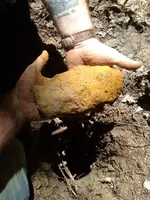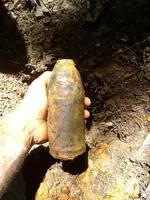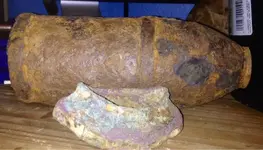You are using an out of date browser. It may not display this or other websites correctly.
You should upgrade or use an alternative browser.
You should upgrade or use an alternative browser.
First shell is a good on CS !
- Thread starter Mark1985
- Start date
dirtlooter
Gold Member
- Joined
- Jun 5, 2014
- Messages
- 8,889
- Reaction score
- 13,499
- Golden Thread
- 0
- Location
- mid western ARK
- 🏆 Honorable Mentions:
- 3
- Detector(s) used
- XP Deus with 9"LF and 9" HF Coils and 600 Equinox with stock and 6" coils
- Primary Interest:
- Relic Hunting
gotta love the history! awesome find with out a doubt!
TheCannonballGuy
Gold Member
- Joined
- Feb 24, 2006
- Messages
- 6,607
- Reaction score
- 13,455
- Golden Thread
- 0
- Location
- Occupied CSA (Richmond VA)
- Detector(s) used
- White's 6000, Nautilus DMC-1, Minelab
- Primary Interest:
- Relic Hunting
Congrats on finding your first civil war artillery shell, Mark. 
In a PM, you asked me about the best way to clean it. I'm replying publically because in the PM you said its iron body is "Graphitized" from being buried for 150 years in "sandy grey creek soil." Your photos here show you're right, that iron is definitely Graphitized. For anybody who is not already familiar with that term, Graphitization is a form of iron corrosion caused by Tannic Acid in slow-moving groundwater (swampy ground, slow-moving creeks, marshes, and "low ground"). The Tannic Acid gradually leaches iron molecules out of the iron relic's skin, and the result looks like Graphite (the same mineral as "pencil lead"). Therefore, the iron is the dull silvery-grey color of Graphite... although sometimes rusting will stain the grey to a brownish-grey, like we see on your Read shell.
VERY IMPORTANT: Graphitized iron relics must NOT be cleaned by either Electrolysis or the Zinc-&-Lye-Bath method. If those cleaning-methods are used, the Graphitized skin of the iron will dissolve -- and the result will be ugly.
Therefore, Graphitized iron relics must be cleaned "manually." I've had good success by using a coarse file and a fine-grain file. I use the coarse file to very gently file down any concretion, until I first start seeing the soft Graphitized iron under the concretion. Caution-note: the Graphitized iron is extremely soft... so you must be super-careful not to file into it. When I first start seeing the soft iron under the concretion, I switch to using the fine-grain file, and use a very light circular motion to smooth the relic's surface. Then I apply four coats of Satin-finish Polyurethane.
Your CS 3" Read shell shows some areas of brownish-grey Graphitized iron, and some areas of orange-ish concretion on top of the Graphitized iron. As described above, I'd use the coarse file to gently file down the concretion, and the fine-grain file to smooth the Graphitized iron which has no concretion on it.
Since you've (probably) never done by-hand cleaning with files on Graphitized iron, I urge you to practice doing it on some Graphitized shell fragments (or other low-value dug iron) before you try it on a precious relic like your first civil war artillery shell.
If you are coming to the huge Richmond relic-show on July 19 & 20, bring your Read shell to my table and I'll demonstrate the filing technique for you.
Here are some photos of Graphitized iron, to help y'all recognize it. Note that the Schenkl shell is dull silvery-grey, and the brass-saboted Parrott shell is brownish-grey in places. The other two photos are a Graphitized cannonball, before and after cleaning by Electrolysis... which stripped off the Graphitized surface of the iron, resulting in a look which resembles the moon's surface.

In a PM, you asked me about the best way to clean it. I'm replying publically because in the PM you said its iron body is "Graphitized" from being buried for 150 years in "sandy grey creek soil." Your photos here show you're right, that iron is definitely Graphitized. For anybody who is not already familiar with that term, Graphitization is a form of iron corrosion caused by Tannic Acid in slow-moving groundwater (swampy ground, slow-moving creeks, marshes, and "low ground"). The Tannic Acid gradually leaches iron molecules out of the iron relic's skin, and the result looks like Graphite (the same mineral as "pencil lead"). Therefore, the iron is the dull silvery-grey color of Graphite... although sometimes rusting will stain the grey to a brownish-grey, like we see on your Read shell.
VERY IMPORTANT: Graphitized iron relics must NOT be cleaned by either Electrolysis or the Zinc-&-Lye-Bath method. If those cleaning-methods are used, the Graphitized skin of the iron will dissolve -- and the result will be ugly.
Therefore, Graphitized iron relics must be cleaned "manually." I've had good success by using a coarse file and a fine-grain file. I use the coarse file to very gently file down any concretion, until I first start seeing the soft Graphitized iron under the concretion. Caution-note: the Graphitized iron is extremely soft... so you must be super-careful not to file into it. When I first start seeing the soft iron under the concretion, I switch to using the fine-grain file, and use a very light circular motion to smooth the relic's surface. Then I apply four coats of Satin-finish Polyurethane.
Your CS 3" Read shell shows some areas of brownish-grey Graphitized iron, and some areas of orange-ish concretion on top of the Graphitized iron. As described above, I'd use the coarse file to gently file down the concretion, and the fine-grain file to smooth the Graphitized iron which has no concretion on it.
Since you've (probably) never done by-hand cleaning with files on Graphitized iron, I urge you to practice doing it on some Graphitized shell fragments (or other low-value dug iron) before you try it on a precious relic like your first civil war artillery shell.
If you are coming to the huge Richmond relic-show on July 19 & 20, bring your Read shell to my table and I'll demonstrate the filing technique for you.
Here are some photos of Graphitized iron, to help y'all recognize it. Note that the Schenkl shell is dull silvery-grey, and the brass-saboted Parrott shell is brownish-grey in places. The other two photos are a Graphitized cannonball, before and after cleaning by Electrolysis... which stripped off the Graphitized surface of the iron, resulting in a look which resembles the moon's surface.
Attachments
-
 graphitization_Schenkl3inch_KellysFordVAriver_ebay_e969_1.webp12.7 KB · Views: 165
graphitization_Schenkl3inch_KellysFordVAriver_ebay_e969_1.webp12.7 KB · Views: 165 -
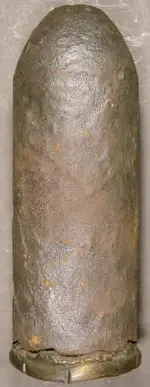 graphitized_Parrot_3point67_PotomacCreekVA_sideview1_A1491.webp12 KB · Views: 162
graphitized_Parrot_3point67_PotomacCreekVA_sideview1_A1491.webp12 KB · Views: 162 -
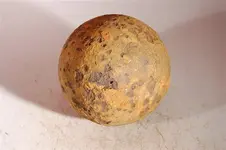 graphitized_roundball_4point62_solidshot_governors_3-19-07%2.webp20.1 KB · Views: 176
graphitized_roundball_4point62_solidshot_governors_3-19-07%2.webp20.1 KB · Views: 176 -
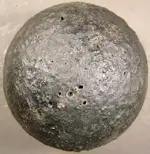 graphitized_roundball_4point62_solidshot_relicman_A1683.webp36.3 KB · Views: 158
graphitized_roundball_4point62_solidshot_relicman_A1683.webp36.3 KB · Views: 158
Last edited:
VOL1266-X
Gold Member
- Joined
- Jan 10, 2007
- Messages
- 5,589
- Reaction score
- 2,910
- Golden Thread
- 0
- Location
- Northern Middle Tennessee
- Detector(s) used
- Fisher 1266-X, F75 X 2
- Primary Interest:
- Relic Hunting
SUPER FIND Mark!!! WTG, Q,.
CSA2K
Hero Member
- Joined
- Jan 24, 2012
- Messages
- 564
- Reaction score
- 108
- Golden Thread
- 0
- Location
- Winchester VA
- Detector(s) used
- This Minelab and this Pro-Pointer.. and that's all I need
- Primary Interest:
- Relic Hunting
Outstanding!
- Joined
- Jun 15, 2008
- Messages
- 35,976
- Reaction score
- 19,507
- Golden Thread
- 0
- Location
- Pennsylvania (USA)
- Primary Interest:
- All Treasure Hunting

CoinandRelicMan
Silver Member
Not much on artillery shells known here , thanks for sharing!
DigIron2
Silver Member
Damn, nice!I am voting banner on this shell!Digging it was quite a rush huh?
Last edited:
- Joined
- Jan 27, 2009
- Messages
- 18,871
- Reaction score
- 12,120
- Golden Thread
- 1
- Location
- South East Tennessee on Ga, Ala line
- 🥇 Banner finds
- 1
- Detector(s) used
- Tesoro Conquistador freq shift
Fisher F75
Garrett AT-Pro
Garet carrot
Neodymium magnets
5' Probe
- Primary Interest:
- All Treasure Hunting
Very nice civil war relic. It sounds like cannonball man has some great tips for your shell.Slow and easy and it will last forever.
Mach1Pilot
Silver Member
- Joined
- Jul 21, 2008
- Messages
- 3,000
- Reaction score
- 1,160
- Golden Thread
- 1
- Location
- Bedford County, PA
- 🥇 Banner finds
- 1
- Detector(s) used
- Minelab, Fisher, Teknetics and more!
- Primary Interest:
- All Treasure Hunting
That's a very nice shell- congrats!
Mark1985
Sr. Member
- Joined
- Jan 3, 2013
- Messages
- 301
- Reaction score
- 343
- Golden Thread
- 0
- Detector(s) used
- whites spectra v3i
- Primary Interest:
- Relic Hunting
- #12
Thread Owner
Was a huge rush to pry her from the earth and cannon is always a wealth of knowledge "cannon I will be coming to that show on Saturday you going to be there"?
TheCannonballGuy
Gold Member
- Joined
- Feb 24, 2006
- Messages
- 6,607
- Reaction score
- 13,455
- Golden Thread
- 0
- Location
- Occupied CSA (Richmond VA)
- Detector(s) used
- White's 6000, Nautilus DMC-1, Minelab
- Primary Interest:
- Relic Hunting
Unless I have a bad accident that puts me in the hospital between now and the show date, I'll be there, at my sales-table. Ask the show's Staff where Pete George's table is. (They don't know me as TheCannonballGuy.)
I'm looking forward to examining your first-one-found civil war shell in real-life. Again, congratulations... and, welcome to the shell-digger club. After the first one, you're hooked on it. So, I'll give you some shell-hunting tips when we talk at the show.
After the first one, you're hooked on it. So, I'll give you some shell-hunting tips when we talk at the show.
I'm looking forward to examining your first-one-found civil war shell in real-life. Again, congratulations... and, welcome to the shell-digger club.
 After the first one, you're hooked on it. So, I'll give you some shell-hunting tips when we talk at the show.
After the first one, you're hooked on it. So, I'll give you some shell-hunting tips when we talk at the show.Nice find.
I appreciate the info that Cannonball gave. Most of the iron objects I find are in that condition. That is some good info to have on hand on how to preserve those items.
I appreciate the info that Cannonball gave. Most of the iron objects I find are in that condition. That is some good info to have on hand on how to preserve those items.
diggervet
Hero Member
- Joined
- Dec 3, 2006
- Messages
- 676
- Reaction score
- 901
- Golden Thread
- 0
- Location
- Mechanicsville, Va.
- Detector(s) used
- Deus XP/Nautilus 2B
- Primary Interest:
- Relic Hunting
Beautiful shell, congratulations!
treblehunter
Gold Member
- Joined
- Jun 18, 2013
- Messages
- 9,675
- Reaction score
- 11,296
- Golden Thread
- 0
- Location
- New Jersey
- Detector(s) used
- Minelab Excalibur II
XP Deus
Garrett pro pointer
XP Deus MI-6 pinpointer
- Primary Interest:
- All Treasure Hunting
Nice find.
Long Island Hunter
Greenie
- Joined
- Jun 18, 2014
- Messages
- 11
- Reaction score
- 2
- Golden Thread
- 0
- Location
- Long Island NY
- Detector(s) used
- Minelab 305
Whites Dual Pro Surf PI
- Primary Interest:
- All Treasure Hunting
Sweet find. Man I wish I lived in your neck of the woods.
FriscoT06
Hero Member
- Joined
- May 2, 2011
- Messages
- 601
- Reaction score
- 655
- Golden Thread
- 0
- Location
- Hatteras Island, NC
- Detector(s) used
- Minelab Excalibur II (retired), Minelab X-Terra 505
- Primary Interest:
- Shipwrecks
Congrats on your first artillery shell!!! What a day!
Davers
Gold Member
- Joined
- Jan 8, 2013
- Messages
- 8,217
- Reaction score
- 7,277
- Golden Thread
- 0
- Location
- N.of , I-285...GA
- Detector(s) used
- Whites Spc xlt & Tesoro Tejon- Now back ...Fisher 1266-X. TRX Pointer. New .Teknetics G2 + . New AT Pro .
- Primary Interest:
- All Treasure Hunting
Sweet Shell .
I,m still hunting my first.
Can I get A State it was dug in?
Davers
I,m still hunting my first.
Can I get A State it was dug in?
Davers
Similar threads
- Suggestion
- Replies
- 23
- Views
- 3K
- Suggestion
- Replies
- 5
- Views
- 552
Users who are viewing this thread
Total: 1 (members: 0, guests: 1)

